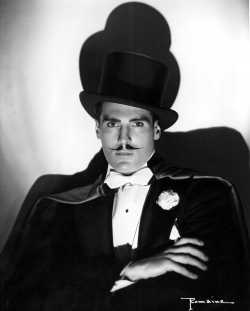
After his aunt gave him the Mysto Magic Kit, Mandrake practiced in a backyard shed, borrowed books from the library, watched magicians at the local Edison Theatre and attended circus shows at the Pacific National Exhibition. One year he was given the props and costumes of a magician who had left the show. He first performed on stage at the Edison Theatre at age eleven in 1922.
For the next three five years the young illusionist appeared at the PNE as Mandrake the Magician. His mentors included Howard Thurston, Claude Alexander, Doc Verge, Bannister and Ralph Richards “The Wizard” who gave him his first out-of-town work in 1927: a six-month tour that ended in Winnipeg.
Mandrake was twice married to his on-stage assistants; first Narda Mandrake from 1939 to 1946, then Velvet Mandrake or “Miss Velvet.” The latter couple honed a two-hour magic show for nightclubs during the 1940s and 1950s.
Called ‘the best-loved magician who ever sawed a woman in half,’ the tuxedoed illusionist and ventriloquist was the inspiration for an unaffiliated comic strip, Mandrake, that ran for decades. Drawn by cartoonist Phil Davis and written by Lee Falk, this strip was created in 1934, in St. Louis, without Mandrake’s prior consent or knowledge.
According to Mandrake’s son Lon Mandrake, a science teacher in Delta, B.C. who also performs magic tricks, Falk claimed he had invented with name Mandrake the Magician coincidentally. When fact met fiction, Phil Davis drew their character to resemble the real Mandrake. Both parties verbally agreed to cross-promote each other with the result that Mandrake the Magician became recognized throughout North America.
During his long career Mandrake entertained royalty and was compared to Houdini. Other Mandrake spin-offs included a television show, a movie and a novel. The ventriloquist Edgar Bergen made Mandrake three dummies for his stage shows.
Mandrake’s publicity stunts were as notorious as his act. He was known for driving a car while blindfolded, hypnotizing a girl in a department store window, making great escapes from boxes and mind reading on the street. Leon and Velvet Mandrake retired to White Rock, B.C. after they quit performing in 1984, ending a 62-year showbiz career.
Mandrake Incomparable (Hades $27.50) by Sheldon O’Connell is a wandering but appreciative biography that culminates in Leon Mandrake’s death at Surrey Hospital on January 27, 1993. A wake was held at the old Edison Theatre in New Westminster, now the Paramount Theatre, the first place Mandrake worked his magic.
Thanks to Jack Bennest of BC Radio History for this info.











 Ivan (Ivor Frederick) Ackery Movie promoter b. Oct. 30, 1899, Bristol, Eng.; d. Oct. 29, 1989, Vancouver, on the eve of his 90th birthday. Moved to Vancouver in 1914. As manager of the
Ivan (Ivor Frederick) Ackery Movie promoter b. Oct. 30, 1899, Bristol, Eng.; d. Oct. 29, 1989, Vancouver, on the eve of his 90th birthday. Moved to Vancouver in 1914. As manager of the